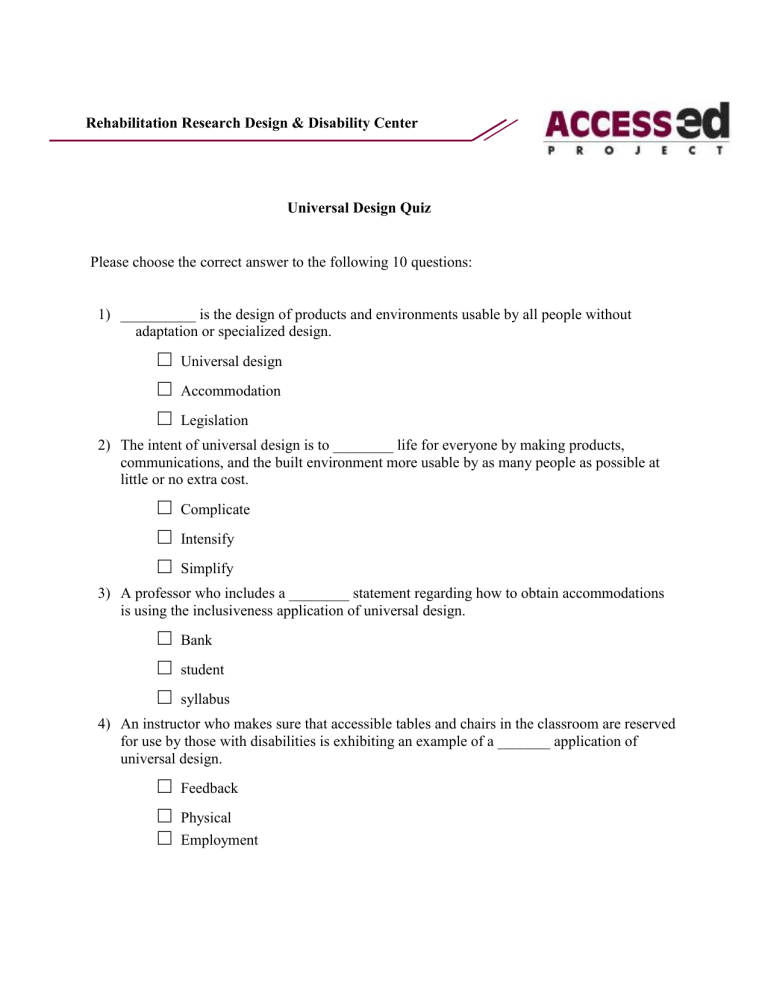Universal Design Quiz: Principles & Applications in Education

Rehabilitation Research Design & Disability Center
Universal Design Quiz
Please choose the correct answer to the following 10 questions:
1) __________ is the design of products and environments usable by all people without
adaptation or specialized design.
□
Universal design
□
Accommodation
□
Legislation
2) The intent of universal design is to ________ life for everyone by making products, communications, and the built environment more usable by as many people as possible at little or no extra cost.
□
Complicate
□
Intensify
□
Simplify
3) A professor who includes a ________ statement regarding how to obtain accommodations is using the inclusiveness application of universal design.
□
Bank
□ student
□ syllabus
4) An instructor who makes sure that accessible tables and chairs in the classroom are reserved for use by those with disabilities is exhibiting an example of a _______ application of universal design.
□
Feedback
□
Physical
□
Employment
Rehabilitation Research Design & Disability Center
Continued:
5) Which one of the following is not a strategy or principle for Universal Design in Education?
□
Use a variety of instructional methods.
□
Allow for multiple methods of demonstrating understanding of essential course content.
□
Use technology to enhance learning opportunities and increase accessibility.
□
Invite students to meet/contact faculty with any questions/concerns.
□
Give shorter exams more frequently.
□
Send students with learning disabilities to take course quizzes at the Learning Center.
True or False Questions (circle one: T or F)
6) T or F Since only a small number of Americans can benefit from
Universal Design; we should not let their needs dictate for everyone.
7) T or F
8) T or F
9) T or F
10) T or F
Universal Design in Education is just good teaching.
Designed access is preferable to retrofitted access because it is more effective and less expensive.
Universal Design is designing services and resources for people from diverse backgrounds with a broad range of abilities and disabilities.
I have a lot more to learn about Universal Design in Education
Some COMMON TEACHING METHODS –
Strengths and Weaknesses
Strengths Limitations Preparation
Lecture
Class
Discussion
*Ensures
Dissemination of specific facts
*Class size is not an issue
*Information and ideas drawn from multiple people
*Student's attention easily maintained
*Little, if any, student participation
*Only learn from one source
*Information to be learned needs to be clearly indicated
*Course instructor should allot adequate time for content to be presented
*Only practical with small classroom
*Some students will monopolize the conversation while others will not engage in discussion
*Course instructor needs to guide discussion and keep group from going
"off-tack"
*Discussion topics/questions should be prepared before class
Role Playing
*Can be very impacting
*Students are able to test concepts and techniques presented in class
*Student may feel "put on the spot"
*Only practical for small classroom
*Course instructor needs to identify rules, situation, and roles
Guest
Speaker
Panel of
Experts
*Provides a real-life example
*Gives students contacts in the field
*Allows for multiple expert opinions and ideas on a topic
*May capture more students' attention
*Quality of the speaker may be poor
*Speakers may be poor quality
*Competition among experts
*Identify and schedule appropriate speakers
*Provide introduction and background of speaker
*Identify and schedule experts
*Provide introduction and background of experts
Videotapes* *Allows for alternate *Students so not have to *Required to operate
means of representation
*Keeps students' attention actively participate
*Unable to control what students learn from video equipment
*Prepare questions for discussion after video
* The Ohio State University Partnership grant strongly recommends that all videotapes be captioned.
IDEAS for IMPLEMENTATION
• Use peer mentoring, group discussions, and cooperative learning situations rather than strictly lecture.
-Put course content on-line allowing students to "pick up" material that might have been missed in lecture
• Using guided notes enables students to listen for essential concepts without copying notes off of overhead
• Update course materials based on current events and student demands
• Provide comprehensive syllabus with clearly identified course requirements, accommodation statement, and due dates
• Fluctuate instructional methods; provide illustrations, handouts, auditory and visual aids
• Clarify any feedback or instructions, ask for questions, and use multiple examples
• Relate a new topic to one already learned or a real-life example
• Secure a note taker, allows the student to tape record lectures or provide him/her with a copy of your notes
• Allow the student to demonstrate knowledge of the subject through alternate means
• Permit and encourage the use of adaptive technology
• Develop study guides
• Give shorter exams more frequently
(From http://www.pstcc.edu/departments/swd/media/ud/ud_quiz.html
)











